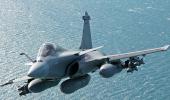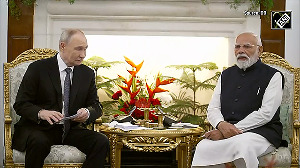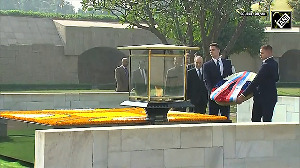'The Indian Air Force attacked 11 of Pakistan's very important airbases, mostly in the plains of Pakistani Punjab.'

Saurav Jha is an author and commentator on geostrategic affairs.
His first book, The Upside Down Book of Nuclear Power was released in 2010, and in 2015, he published The Heat and Dust Project, co-written with Devapriya Roy, which chronicles a backpacking trip through India on an extremely tight budget.
In 2017, he founded Delhi Defence Review, a think-tank focused on the analysis of technology, war, and ideas.
In an exclusive interview to Rediff Senior Contributor Sheela Bhatt. Jha evaluates Operation Sindoor. The first of a two-part interview:
First let us know your take on Operation Sindoor.
Operation Sindoor in military terms would be considered successful, but, whether it will serve the purpose of deterring Pakistan or not is of course debatable.
Ideally, the Indian Air Force's operational tempo should have been allowed to continue for a little longer, but, of course, we don't live in an ideal world.
We do live in a world of nuclear overhang and international pressure as it were.
But a slightly longer operation would have allowed the Indian Air Force to inflict a certain quantum of punishment on the Pakistan air force which, in my opinion, would have had a greater deterrent value.
Like?
More of their aircraft could have been destroyed on the ground. On the lines of the strike on the Bholari airbase, which has probably accounted for one of their Saab 2000 Erieye Airborne Warning and Control System (AWACS) aircraft.
An AWACS is basically airborne radar mounted on a business jet or a transport platform which allows you to get a much better air situation picture.
It allows you to track many more enemy air assets while they are airborne.
It gives you a very clear picture of the air war if you like or the air battle scenario, as may be underway.
Don't you think that Indian defence forces must have done some simulation? Some kind of thought process must have gone in this?
What must be in the mind of the Indian Army, defence forces on the eve of the attack?
So the Indian military, I mean all three services together -- army, air force and navy -- they have in the past wargamed a scenario called 10i.
This was revealed by the late General Bipin Rawat when he was CDS and it was also reported in the press.
So this is a scenario where an escalatory spiral leads to an intensive military engagement with the Pakistan armed forces.
And it takes only about ten days to significantly attrite their forces and leave no doubt as to which is the dominant military in the subcontinent.
And this would be accomplished below Pakistan's perceived nuclear redlines.

Which are those redlines?
If you go by what the Pakistan armed forces or one of the former heads of their strategic plans division has gone around saying across the world, it seems Pakistan has four nuclear redlines -- thresholds for embarking on a nuclear first strike.
So, basically Pakistan will escalate to the nuclear level if any of these 'redlines' were to be crossed.
The First redline is if there is any significant territorial loss. This could lead to a nuclear escalation by Pakistan.
The Second redline relates to an economic strangulation of Pakistan which could trigger a nuclear response.
The Third redline pertains to large scale internal subversion or political instability.
So, a foreign power could be subject to a nuclear first strike by Pakistan if it is perceived to be breeding internal instability that threatens the very existence of the Pakistani State.
The Fourth redline relates to the possibility of significant destruction of Pakistan's air and naval forces.
Now in my view this fourth redline is the least credible of all four.
Of course, this internal instability threshold is also a little nebulous.
In Operation Sindoor we were not close to touching any of these red lines.
At least till the point at which Operation Sindoor was stopped I don't see us having breached any of Pakistan's red lines although Pakistan did posture in a dicey manner.
It was reported that the Pakistanis held a meeting of their national command authority (although this was later denied by their defence minister).

How do you view the acceptance of a ceasefire, India calls it understanding?
Any ceasefire built on foundations such as this will be considered fragile in military terms. Has anything changed materially on the ground?
Yes, India has shown that it can directly attack multiple targets within Pakistan, both civil and military.
But does that mean that the Pakistanis are deterred for good from their terrorism export policy? That is debatable.
In my view, the answer is not a resounding no, nor is it a comprehensive yes, because there are other actors involved.
Like?
Like the two superpowers of today which is the United States of America and the People's Republic of China.
When India deals with Pakistan, it must be understood, India is not dealing with just Pakistan.
At every point that is quite clear. More than 80% of Pakistan's current inventory of major weapons comes from China.
That is to say, they are of Chinese origin. On top of that you have very specific capable systems which have come from the United States of America.
We all know about the F-16 block 52+s which are there in the Pakistan air force, but it should also be know that the best ground-based radar fielded by the Pakistanis are also from America.
For example, the Lockheed Martin AN/TPS-77 radar, which is an early warning kind of system, is from America.
And that is a contemporary system. So when you deal with Pakistan, you must understand that their policies are not going to be shaped only as a function of their interaction with India.

India is well aware of these details, right?
It is, but do note that when Operation Sindoor began, the noises emanating from America were a little different from what they were towards the end.
If you remember, J D Vance gave an interview where he said that this is not really any of our business and stuff like that, so contradictory noises have come from the US.
There was no official noise from China except to the effect that they wanted to see both parties settle on a ceasefire and sort of pull back from the brink or whatever you want to call it.
They sent messages via unofficial channels like Chinese scholars.
For instance, Victor Gao, who can be considered a part of the Chinese establishment, although some people might contest that, said on one of the TV channels that China will not allow its 'iron brother' Pakistan to face defeat beyond a point or words to that effect.
So the thing is that Pakistan is a nuclear weapon state. But Pakistan has also been buffered up continuously by China and to an extent by America also in terms of conventional weaponry.

But, since ages we know.
But, it's not as if we have not gone ahead either. Look at the step wise escalation that is happening in India's posture.
In 2016 all that India did after Uri was launch some surgical strikes across the LoC.
Pakistan denied that any such surgical strike had taken place.
After that, you had the Balakot strike where we actually hit, what the government said, is a non-military target inside Pakistan.
Then you had a brief air battle and then there were contesting claims but it seems by all accounts based on electronic evidence provided by the Indian Air Force, that a Pakistani F16 did go down in 2019.
Today with Operation Sindoor we have gone way beyond what western analysts used to think was possible.
Nine separate terrorist targets were prosecuted at once inside Pakistan, deep inside Pakistan.
After that, you had the escalatory spiral, Pakistan responded, we responded and then, of course, Pakistan crossed the Rubicon by launching a ballistic missile in the direction of Delhi, which was intercepted over Sirsa by an MRSAM (Medium Range Surface-to-Air Missile).
On May 10 the Indian Air Force showed what it is really capable of. We attacked 11 of their very important airbases, mostly in the plains of Pakistani Punjab.

But not substantial destruction was done.
Because the agenda was to keep to the escalatory ladder. The agenda was to disable them for a period of time.
- Part II of the Interview: 'Why Couldn't Pakistan Stop Indian Attacks?'
Feature Presentation: Aslam Hunani/Rediff.com










